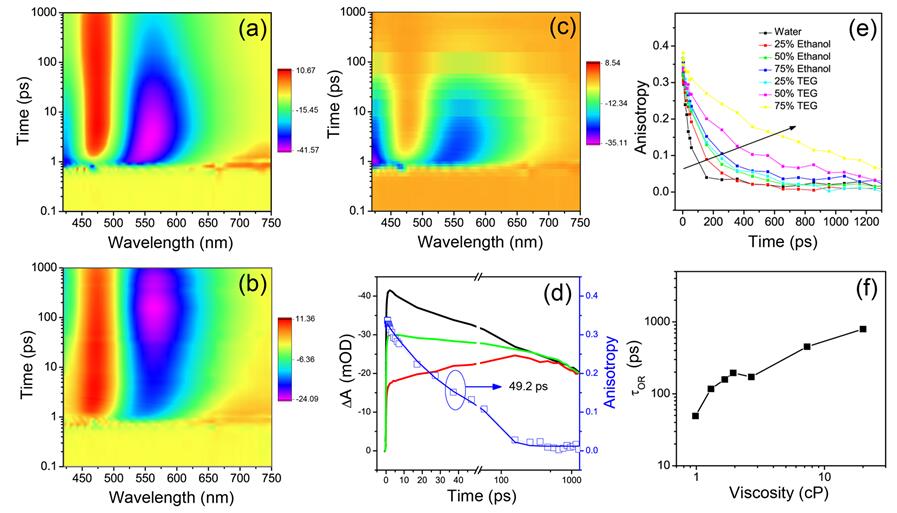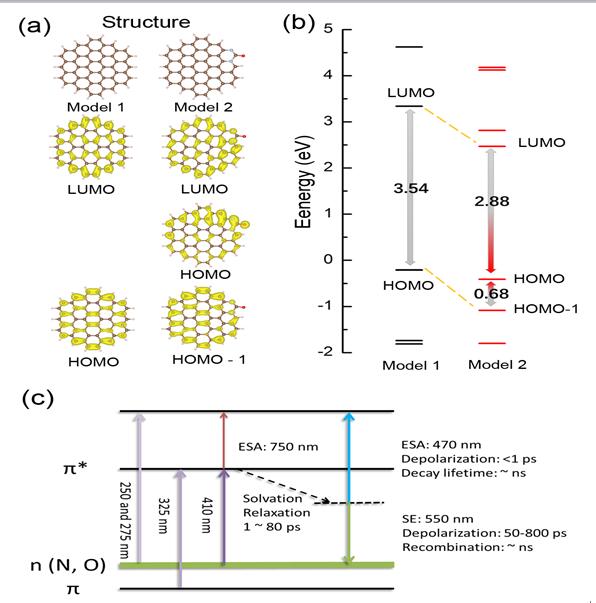Author: |
Professor Songnan Qu and his team at CIOMP revealed the photoluminescence (PL) of hetero-atom doped carbon nanodots (CDots) is originated from a kind of dipole emission centers through systematical studying solvent effect on solvation and depolarization processes by polarization dependent femtosecond transient absorption (TA) spectroscopy and computational simulation.
This work was recently published in the journal Advanced Optical Materials. The first author is associate professor Pengtao Jing. This work also thanks for the best cooperation with Professor Hong Zhang in Van’t Hoff Institute for Molecular Sciences, University of Amsterdam, the Netherlands.
Carbon nanodots, as an emerging new luminescent nanomaterials with sizes less than 10 nm, have been attracting much attentions and demonstrating a great potential application in bioimaging, photocatalysis, photovoltaics, light emitting diodes, and lasing materials, due to their distinct merits, such as biocompatibility, bright fluorescence, high photostability and low cost. Recently, anisotropic PL of single CDot was proved to come from electric dipole via the scanning of azimuthally polarized laser beam at focal region.Therefore, CDots show a potential application in polarization modulation based super-resolution microscopy. However, the anisotropic PL origin of CDots remains under debate.
In the current study, Prof. Qu’s team studied the anisotropic PL in hetero-atom doped CDots using polarization dependent femtosecond transient absorption spectroscopy and computational simulation. Anisotropic absorption and stimulated emission of CDots were observed in different solvents. Solvent effect on solvation relaxation was observed for CDots in different solvents, reflecting the dipole-dipole interaction between CDots and polar solvent molecules, as shown in Figure 1.
Depolarization process was observed not only dependent on solvent viscosity but also related on the proton donation capability of solvent. The experimental and computational results reveal the anisotropic PL of CDots originates from neither intrinsic nor extrinsic states, but originates from n-π* transition of a hybrid state, in which the highest occupied molecular orbital is localized at dopant atoms (such as pyridinic N and carbonyl O) and the lowest unoccupied molecular orbital is delocalized over graphene-like domain, as show in Figure 2. These results are benefit for well understanding the origin of the anisotropic PL from CDots.

Figure 1. Top viewed TA spectra of CDots in water, when polarizations of pump and probe were set to (a) parallel and (b) perpendicular. (c) The difference spectrum between parallel and perpendicular TA spectra. (d) TA kinetic traces of CDots probed at 550 nm. (Black, red and green lines represent the parallel, perpendicular and magic angle polarizations. Blue line is the calculated anisotropy as a function of delay time). (e) Time-dependent polarization anisotropy of CDots in different solvents. (f) Reorientation times for CDots vs. viscosity of solvents.(Photo by CIOMP)

Figure 2. (a) Calculated structures of Model 1 and Model 2. The charge distributions of LUMO, HOMO and HOMO-1. The colored isosurface of charge density is 0.001 e/Å3. (b) Energy levels of Model 1 and Model 2. (c) Model of absorption, solvation relaxation, stimulated emission and excited state absorption processes in N and O doped CDots..(Photo by CIOMP)
Article link: http://onlinelibrary.wiley.com/doi/10.1002/adom.201601049/full
Contact:
Prof. Songnan Qu, Changchun Institute of Optics, Fine Mechanics and Physics
Email: qusn@ciomp.ac.cn
